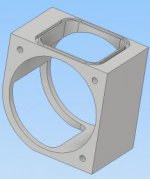I am assigned a part I have no idea how to make it and would like some advice.

There is a 4" bore hole 3" deep in the middle of a 303 block. A round shaft fits inside this and spins with clearance around it. The tolerance I am looking at for the hole is +-.001".
My current plan is to drill through with a 3/4" drill, rough out with a 3/4" long carbide end mill taking 1/2" deep cuts to the bottom, then using the 3/4" to do a facing of the outside of the hole in one pass.
I also think this is a horrible plan. I found that when I machined a prior prototype from steel doing the above plan it chatter like hell due to the cutter length. I found doing plunges with the end mill proved to make no chatter and I left a 0.010" wall to do in a final pass. From what I know about 303, this may not be a solid plan due to work hardening.
My other option I am contemplating is drilling a 1" hole and buying a boring bar set to gradually bore out the hole to the final diameter.
Any suggestions of what I could do?
I'm self taught machinist, mechanical engineer, running a Deckel FP50CC/T with a Dialog 11 controller. I have been using this machine for a few years now and have a solid grasp of how to write code on the machine and some CAM experience. I have Autodeks Inventor's basic HSM, but I haven't written the post processor and the ones online and provided are not correct. I have to do a lot of manual fixes to the Autodesk's output. I have also made post processors for CamBam and a few other small CAM programs, but they do not have HSM tool paths.

There is a 4" bore hole 3" deep in the middle of a 303 block. A round shaft fits inside this and spins with clearance around it. The tolerance I am looking at for the hole is +-.001".
My current plan is to drill through with a 3/4" drill, rough out with a 3/4" long carbide end mill taking 1/2" deep cuts to the bottom, then using the 3/4" to do a facing of the outside of the hole in one pass.
I also think this is a horrible plan. I found that when I machined a prior prototype from steel doing the above plan it chatter like hell due to the cutter length. I found doing plunges with the end mill proved to make no chatter and I left a 0.010" wall to do in a final pass. From what I know about 303, this may not be a solid plan due to work hardening.
My other option I am contemplating is drilling a 1" hole and buying a boring bar set to gradually bore out the hole to the final diameter.
Any suggestions of what I could do?
I'm self taught machinist, mechanical engineer, running a Deckel FP50CC/T with a Dialog 11 controller. I have been using this machine for a few years now and have a solid grasp of how to write code on the machine and some CAM experience. I have Autodeks Inventor's basic HSM, but I haven't written the post processor and the ones online and provided are not correct. I have to do a lot of manual fixes to the Autodesk's output. I have also made post processors for CamBam and a few other small CAM programs, but they do not have HSM tool paths.


